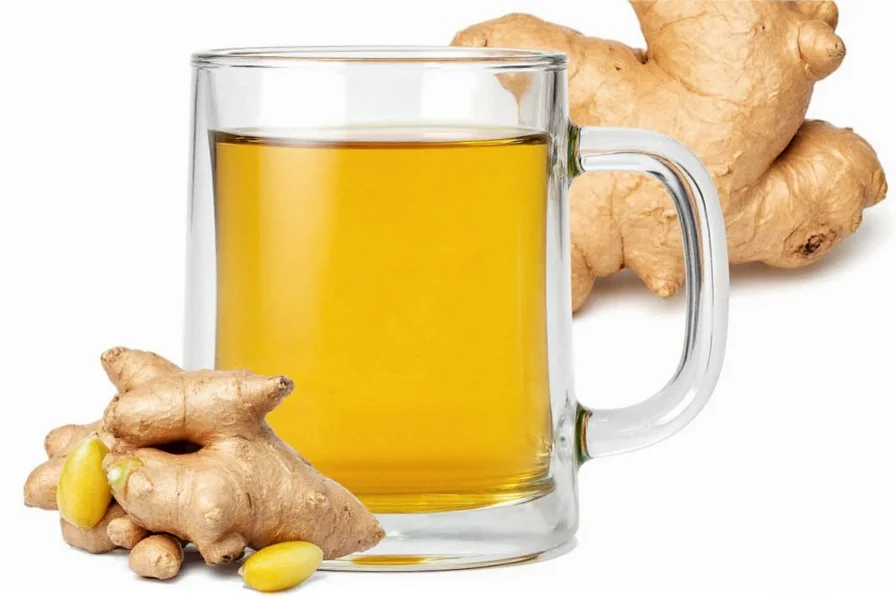Salabat (pronounced sah-lah-baht) represents more than just a beverage in Filipino culture—it's a time-honored remedy with genuine health properties backed by growing scientific evidence. This simple preparation of fresh ginger root steeped in hot water has been used for generations across the Philippines to address various health concerns, from common colds to digestive discomfort.
What Exactly Is Salabat Ginger Tea?
Unlike commercial ginger teas that may contain additives or dried ginger powder, authentic salabat uses freshly sliced or crushed ginger root boiled in water. The Filipino tradition typically involves simmering 2-3 inches of peeled, sliced ginger in 2-4 cups of water for 10-15 minutes, sometimes with additions like calamansi (Philippine lime) or honey. This preparation method maximizes the extraction of ginger's bioactive compounds compared to many store-bought alternatives.
Science-Backed Health Benefits of Salabat
Powerful Anti-Inflammatory Effects
Ginger contains potent anti-inflammatory compounds called gingerols, with 6-gingerol being the most studied. Research published in the Journal of Medicinal Food demonstrates that ginger extract significantly reduces markers of inflammation in the body. Regular consumption of salabat may help manage chronic inflammatory conditions like osteoarthritis. A clinical trial found that ginger extract provided moderate pain relief for osteoarthritis patients, with effects comparable to some conventional medications but with fewer side effects.
| Key Compound | Natural Source | Concentration in Salabat | Primary Health Effect |
|---|---|---|---|
| 6-Gingerol | Fresh ginger root | High (when freshly prepared) | Anti-inflammatory, antioxidant |
| 6-Shogaol | Formed when ginger is heated | Moderate (increases with simmering) | Pain relief, anti-nausea |
| Zingerone | Formed during cooking | Low to moderate | Antioxidant, antimicrobial |
Digestive System Support
One of the most well-documented traditional uses of salabat—improving digestion—has strong scientific backing. Ginger stimulates gastric motility and accelerates stomach emptying, which explains why Filipinos traditionally drink it after meals. A systematic review in Nutrients journal confirmed ginger's effectiveness in treating functional dyspepsia and reducing nausea. The same review noted ginger's potential benefits for irritable bowel syndrome symptoms, particularly abdominal pain and bloating.

Immune System Enhancement
During cold and flu season, many Filipinos turn to salabat as a preventive measure. Research suggests this traditional practice has merit—ginger contains compounds that may enhance immune cell activity. A study in the Journal of Ethnopharmacology found that ginger extract increased the production of certain immune cells in laboratory tests. While not a cure for infections, regular consumption of salabat may strengthen the body's natural defenses against common pathogens.
Respiratory Relief
The warming, spicy nature of salabat makes it particularly valuable for respiratory issues. Scientific analysis shows ginger compounds can help relax airway muscles and reduce inflammation in the respiratory tract. This explains why salabat effectively soothes sore throats and eases coughing. The steam from hot salabat also helps clear nasal passages, providing immediate relief from congestion—a benefit recognized in traditional Filipino medicine for generations.
Antioxidant Protection
Ginger ranks highly on the ORAC (Oxygen Radical Absorbance Capacity) scale, indicating significant antioxidant capacity. These antioxidants combat oxidative stress, which contributes to aging and chronic diseases. Unlike many antioxidant sources that lose potency when heated, ginger's key compounds remain stable during the preparation of salabat, making this traditional preparation method particularly effective for delivering antioxidant benefits.
Traditional Filipino Uses vs. Scientific Evidence
Many traditional applications of salabat align remarkably well with modern scientific understanding. Filipinos have long used it for:
- Morning sickness during pregnancy (research confirms ginger's anti-nausea effects)
- Menstrual pain relief (studies show ginger reduces prostaglandins that cause cramps)
- Cold and flu symptoms (supported by ginger's immune-modulating properties)
- Digestive upset after rich meals (validated by ginger's effects on gastric motility)
While traditional knowledge shouldn't replace medical treatment, the convergence between Filipino folk medicine and contemporary research regarding salabat ginger tea is noteworthy and scientifically plausible.
How to Prepare Authentic Salabat for Maximum Benefits
To experience the full traditional Filipino salabat ginger tea benefits, preparation matters. Here's the authentic method:
- Peel 2-3 inches of fresh ginger root
- Slice thinly or crush to increase surface area
- Simmer in 2-4 cups of water for 10-15 minutes (longer simmering increases shogaol content)
- Strain and optionally add calamansi or a small amount of honey
- Drink while warm, preferably without milk which may reduce absorption of active compounds
For therapeutic effects, consuming salabat 1-2 times daily provides consistent exposure to ginger's beneficial compounds. Unlike many commercial ginger teas that use dried ginger with reduced potency, fresh preparation maximizes the bioactive compounds.
Important Considerations and Potential Side Effects
While salabat ginger tea offers numerous health advantages, certain precautions are necessary:
- May interact with blood-thinning medications (consult your doctor if taking anticoagulants)
- Excessive consumption (more than 4 grams of ginger daily) may cause heartburn or mouth irritation
- Pregnant women should limit intake to 1 gram of ginger daily unless approved by their healthcare provider
- Those with gallstone issues should consult a physician before regular consumption
As with any natural remedy, moderation is key. Salabat works best as part of a balanced approach to health rather than a standalone solution for serious medical conditions.
Conclusion: The Enduring Value of Salabat
Salabat ginger tea represents a perfect intersection of traditional Filipino wisdom and modern scientific validation. Its preparation method preserves the bioactive compounds responsible for its health-promoting properties, making it more than just a cultural tradition—it's a practical, accessible health practice with genuine benefits. Whether you're seeking relief from digestive discomfort, respiratory symptoms, or simply looking to incorporate more natural anti-inflammatory agents into your routine, authentic salabat offers a time-tested solution grounded in both cultural heritage and scientific evidence.
Frequently Asked Questions
How often should I drink salabat ginger tea for health benefits?
For general health maintenance, 1-2 cups of salabat daily provides optimal benefits without risk of side effects. Those using it for specific therapeutic purposes like digestive issues may benefit from consuming it 20-30 minutes before meals. However, don't exceed 4 grams of ginger daily (approximately 2-3 cups of strong salabat) to avoid potential gastrointestinal discomfort.
Can children safely consume salabat ginger tea?
Children over 2 years can safely consume diluted salabat (using half the ginger amount for adults) in moderation. For children 2-6 years, limit to ¼ cup once daily; for children 6-12 years, ½ cup once daily. Always consult a pediatrician before giving ginger tea to children with medical conditions or who are taking medications, as ginger may interact with certain drugs.
Does salabat ginger tea help with weight loss?
While salabat isn't a weight loss solution, it may support healthy weight management indirectly. Ginger has been shown to increase thermogenesis (calorie burning) slightly and may help regulate blood sugar levels, reducing cravings. Additionally, drinking salabat before meals may promote feelings of fullness. However, significant weight loss requires comprehensive dietary and lifestyle changes, not just ginger tea consumption.
How does salabat differ from regular ginger tea?
Authentic salabat uses freshly sliced or crushed ginger root simmered in water, while many commercial ginger teas use dried ginger powder or extracts. Fresh preparation preserves higher levels of active compounds like gingerol. Traditional salabat is typically stronger and more pungent than most store-bought versions, which often contain additional ingredients like herbs, sweeteners, or flavorings not part of the original Filipino preparation method.
When is the best time to drink salabat for maximum benefits?
The optimal timing depends on your health goals: drink 20 minutes before meals for digestive benefits, before bedtime for respiratory relief during colds, or in the morning for general immune support. For nausea relief, consume at the first sign of symptoms. Avoid drinking salabat immediately before surgery or dental procedures due to potential blood-thinning effects.











 浙公网安备
33010002000092号
浙公网安备
33010002000092号 浙B2-20120091-4
浙B2-20120091-4